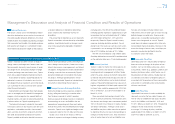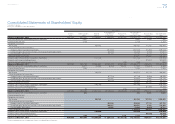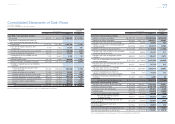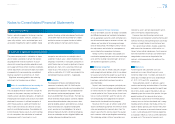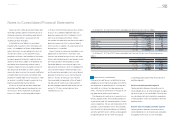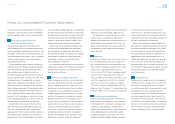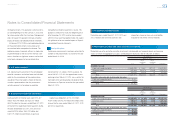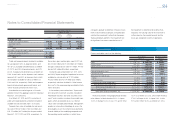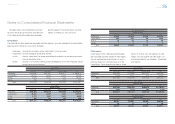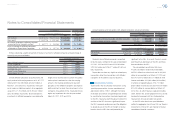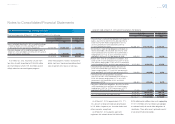Toyota 2013 Annual Report Download - page 81
Download and view the complete annual report
Please find page 81 of the 2013 Toyota annual report below. You can navigate through the pages in the report by either clicking on the pages listed below, or by using the keyword search tool below to find specific information within the annual report.
Toyota Global Vision President’s Message Launching a New Structure Special Feature Review of Operations
Consolidated Performance
Highlights
Management and
Corporate Information Investor InformationFinancial Section
Page 81
NextPrev
ContentsSearchPrint
ANNUAL REPORT 2013
Reserve rates are calculated mainly by historical loss
experience, current economic events and conditions
and other pertinent factors such as used car markets.
Wholesale and other dealer loan
receivables portfolio segment
Toyota calculates allowance for credit losses to
cover probable losses on wholesale and other deal-
er loan receivables by applying reserve rates to such
receivables. Reserve rates are calculated mainly by
fi nancial conditions of the dealers, terms of collateral
setting, current economic events and conditions
and other pertinent factors.
Toyota establishes specifi c reserves to cover the
estimated losses on individually impaired receivables
within the wholesale and other dealer loan receiv-
ables portfolio segment. Specifi c reserves on
impaired receivables are determined by the present
value of expected future cash fl ows or the fair value
of collateral when it is probable that such receiv-
ables will be unable to be fully collected. The fair
value of the underlying collateral is used if the receiv-
able is collateral-dependent. The receivable is deter-
mined collateral-dependent if the repayment of the
loan is expected to be provided by the underlying
collateral. For the receivables in which the fair value
of the underlying collateral was in excess of the out-
standing balance, no allowance was provided.
Troubled debt restructurings in the retail receiv-
ables and fi nance lease receivables portfolio seg-
ments are specifi cally identifi ed as impaired and
aggregated with their respective portfolio segments
when determining the allowance for credit losses.
Impaired loans in the retail receivables and fi nance
levels to determine whether reserves are considered
adequate to cover the probable range of losses.
The allowance for residual value losses is main-
tained in amounts considered by Toyota to be
appropriate in relation to the estimated losses on its
owned portfolio. Upon disposal of the assets, the
allowance for residual losses is adjusted for the dif-
ference between the net book value and the pro-
ceeds from sale.
Inventories
Inventories are valued at cost, not in excess of mar-
ket, cost being determined on the “average-cost”
basis, except for the cost of fi
nished products car-
ried by certain subsidiary companies which is deter-
mined on the “specifi c identifi cation” basis or
“last-in, fi rst-out” (“LIFO”) basis. Inventories valued
on the LIFO basis totaled ¥220,582 million and
¥220,082 million ($2,340 million) at March 31, 2012
and 2013, respectively. Had the “fi rst-in, fi rst-out”
basis been used for those companies using the
LIFO basis, inventories would have been ¥56,799
million and ¥66,979 million ($712 million) higher than
reported at March 31, 2012 and 2013, respectively.
Property, plant and equipment
Property, plant and equipment are stated at cost.
Major renewals and improvements are capitalized;
minor replacements, maintenance and repairs are
charged to current operations. Depreciation of
property, plant and equipment is mainly computed
on the declining-balance method for the parent
company and Japanese subsidiaries and on the
straight-line method for foreign subsidiary companies
lease receivables portfolio segments are insignifi cant
for individual evaluation and Toyota has determined
that allowance for credit losses for each of the retail
receivables and fi nance lease receivables portfolio
segments would not be materially different if they
had been individually evaluated for impairment.
Specifi c reserves on impaired receivables within
the wholesale and other dealer loan receivables
portfolio segment are recorded by an increase to
the allowance for credit losses based on the related
measurement of impairment. Related collateral, if
recoverable, is repossessed and sold and the
account balance is written-off.
Any shortfall between proceeds received and the
carrying cost of repossessed collateral is charged to
the allowance. Recoveries are reversed from the
allowance for credit losses.
Allowance for residual value losses
Toyota is exposed to risk of loss on the disposition
of off-lease vehicles to the extent that sales proceeds
are not suffi cient to cover the carrying value of the
leased asset at lease termination. Toyota maintains
an allowance to cover probable estimated losses
related to unguaranteed residual values on its owned
portfolio. The allowance is evaluated considering
projected vehicle return rates and projected loss
severity. Factors considered in the determination of
projected return rates and loss severity include his-
torical and market information on used vehicle
sales, trends in lease returns and new car markets,
and general economic conditions. Management
evaluates the foregoing factors, develops several
potential loss scenarios, and reviews allowance
at rates based on estimated useful lives of the
respective assets according to general class, type
of construction and use. The estimated useful lives
range from 2 to 65 years for buildings and from 2 to
20 years for machinery and equipment.
Vehicles and equipment on operating leases to
third parties are originated by dealers and acquired
by certain consolidated subsidiaries. Such subsid-
iaries are also the lessors of certain property that
they acquire directly. Vehicles and equipment on
operating leases are depreciated primarily on a
straight-line method over the lease term, generally
from 2 to 5 years, to the estimated residual value.
Incremental direct costs incurred in connection with
the acquisition of operating lease contracts are cap-
italized and amortized on a straight-line method
over the lease term.
Long-lived assets
Toyota reviews its long-lived assets for impairment
whenever events or changes in circumstances indi-
cate that the carrying amount of an asset group
may not be recoverable. An impairment loss would
be recognized when the carrying amount of an
asset group exceeds the estimated undiscounted
cash fl ows expected to result from the use of the
asset and its eventual disposition. The amount of
the impairment loss to be recorded is calculated by
the excess of the carrying value of the asset group
over its fair value. Fair value is determined mainly
using a discounted cash fl ow valuation method.
Notes to Consolidated Financial Statements
Selected Financial Summary (U.S. GAAP) Consolidated Segment Information Consolidated Quarterly Financial Summary Management’s Discussion and Analysis of Financial Condition and Results of Operations Consolidated Financial Statements Notes to Consolidated Financial Statements [4 of 44]
Management’s Annual Report on Internal Control over Financial Reporting Report of Independent Registered Public Accounting Firm


